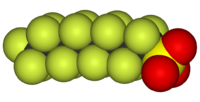
Photo from wikipedia
Per- and polyfluoroalkyl substances (PFASs) are a novel class of emerging persistent organic pollutants (POPs) owing to their environmental persistence and bioaccumulation. Red swamp crayfish is a major source of… Click to show full abstract
Per- and polyfluoroalkyl substances (PFASs) are a novel class of emerging persistent organic pollutants (POPs) owing to their environmental persistence and bioaccumulation. Red swamp crayfish is a major source of exposure to PFASs, while the dietary intake of PFASs from crayfish is still unclear. We investigated the concentrations of PFASs in 130 batches of crayfish and 100 environmental samples from Middle and Lower Reaches of the Yangtze River Delta. Seven Perfluoroalkyl carboxylic acids (PFCAs), 3 Perfluoroalkyl sulfonates (PFSAs), and 6:2 Cl-PFESA were analyzed by ultra-high performance liquid chromatography-tandem mass spectrometry (UPLC-MS/MS). Meanwhile, PFASs exposure levels were examined concretely in four tissues of crayfish and different circulation links. The average daily intake (ADI) risk model was used to evaluate the human health risk of consuming crayfish and suggested that the risk of PFASs exposure is at a low level.
Journal Title: Journal of agricultural and food chemistry
Year Published: 2022
Link to full text (if available)
Share on Social Media: Sign Up to like & get
recommendations!